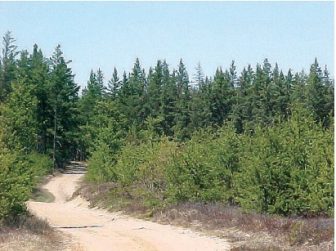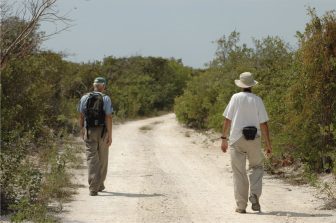
The Kirtland’s warbler is one of the rarest songbirds in North America, living only in Michigan and parts of Wisconsin and Ontario during breeding season. Image: U.S. Fish and Wildlife Service
By Clara Lincolnhol
The Kirtland’s warbler has an expansive conservation program, draws tourists from across the globe and even has an annual festival in Roscommon, Michigan.
Yet what is perhaps Michigan’s most well-known endangered bird is slated to lose its name. It is among 70 North American bird species named after people that will receive new names over the next four years, according to the American Ornithological Association, the organization responsible for classifying North American birds. About a third of them live in the Great Lakes region –
25 in Minnesota, 24 in Illinois, 21 in Michigan, 21 in Ohio, 20 in Indiana,16 in Wisconsin,15 in New York, 13 in Pennsylvania.
Some bird names may have harmful, controversial and even racist connotations, said Erica Nol, a professor of biology and ecology at Trent University in Ontario, and a member of the ornithological association’s North American Classification Committee. The thick-billed longspur, for example, was known as McCowen’s longspur until 2020. McCowen, an amateur bird collector, was also a Confederate general.
The association decided to change the names of all birds named after people last November. Details of how and when this will happen are still being worked out, said Colleen Handel, president of the association. The plan is to involve the public.

Kirtland’s warblers nest in Michigan jack pine trees in the summer. Image: MSU Forestry Extension Team
Ironically, the Kirtland’s warbler is named for Jared Potter Kirtland, an abolitionist whose home was a stop on the Underground Railroad. Kirtland was a physician, botanist and naturalist. He improved farm harvests and conditions in Ohio’s state prisons and is a founder of the Cleveland Museum of Natural History, said Bill Rapai, director of the Kirtland’s Warbler Alliance and author of a book on the bird’s conservation.
But the committee says naming birds after people also fails to describe them. Changing the common names to reflect a bird’s physical and behavioral characteristics helps with identification, Nol said.
And avoiding naming birds for people keeps the association from spending time debating the moral character of the namesake. Discussions about “bird people” take away much needed conservation focus from the actual birds, Nol said. Nearly 3 billion breeding adult birds have been lost throughout ecosystems since 1970.
The American Ornithological Society first tried to identify birds with names associated with problematic individuals, Nol said. But this process was ambiguous.
“We decided, how are we going to do this as ornithologists? Just how are we going to decide who is good and who is bad?” Nol said.
Rapai understands and supports the ornithological society’s decision, especially in cases of harmful, racist names. But he worries how it will affect warbler conservation.
“People who have been working to conserve the Kirtland’s warbler have spent decades building up goodwill for the bird,” Rapai said. “It is going to be very difficult to help the public keep up with this name change and we truly risk losing a connection that has been made with birders worldwide.”
The Kirtland’s Warbler Conservation Team is responsible for the bird’s conservation, he said. It includes Michigan and Wisconsin conservation agencies, U.S. Forest Service, U.S. Fish and Wildlife Service, the Bahamas National Trust, The Kirtland Warbler Alliance and others.
Annual birdwatching tours run by the Michigan Audubon Society sell out every year, attracting people interested in seeing a Kirtland’s warbler for themselves. The U.S. Forest Service, the Chicago Ornithological Society and private groups also run similar tours throughout northern Michigan.
Conservation must be fueled by human interest since we’ve created the challenges for the bird, Rapai said.
Deciding new names poses challenges. The Kirtland’s warbler is also referred to as the “jack pine warbler,” named after the tree where it nests in Michigan. While that may seem like an easy name switch, the bird spends most of its time in the Bahamas, living in dense thickets of low-lying shrubs and small trees known as coppiced woodland.

Biologists in the Bahamas walk through the Kirtland’s warbler’s winter habitat. Image: Bill Rapai
Input from Bahamian birders needs to be considered. “If we rename it “the jack pine warbler” are we really being inclusive?” Rapai said. “Are we just forgetting about the coppice habitat where it spends the majority of its time?”
The decision has ruffled some feathers. An online petition opposing the change is signed by about 6,000 people and includes statements from those who disagree.
The American Ornithological Society should return to the previous case-by-case renaming method to remove offensive names, rather than dishonoring people who founded ornithology in the Americas, said Rachel Kolokoff Hopper, the petition organizer.
Matt Igleski, executive director of the Chicago Bird Alliance, said that some people want to retain the names because they feel that they honor those who contributed to ornithology. But the scientific names—many which reference those people – will remain unchanged, he said.
The committee’s final report lists many reasons for not returning to the case-by-case name change method, Nol said. “The focus will be on the birds and not a committee discussing whether so and so is a worthy person or not.”
At the same time and for the same reasons, former Midwest Audubon societies, like the Detroit Bird Alliance and the Chicago Bird Alliance, changed their names when the committee released their decision.
Rapai said he recognizes the necessity of the name changes, but also recognizes the complexities it brings.
“Yes, I understand the need,” said Rapai. “But this change will have a much deeper impact on our efforts to conserve the warbler in the future.”
The common names of these Great Lakes regional birds reference people. They are among those slated to be changed. Scientific names are unchanged.
- Baird’s sandpiper
- Barrow’s goldeneye
- Bell’s vireo
- Bewick’s wren
- Bicknell’s thrush
- Blackburnian warbler
- Bonaparte’s gull
- Brewer’s blackbird
- Clark’s grebe
- Cooper’s hawk
- Forster’s tern
- Franklin’s gull
- Harris’s sparrow
- Henslow’s sparrow
- Hudsonian godwit
- Kirtland’s warbler
- LeConte’s sparrow
- Lincoln’s sparrow
- Nelson’s sparrow
- Ross’s goose
- Sabine’s gull
- Say’s phoebe
- Smith’s longspur
- Swainson’s hawk
- Swainson’s thrush
- Wilson’s phalarope
- Wilson’s snipe
- Wilson’s warbler